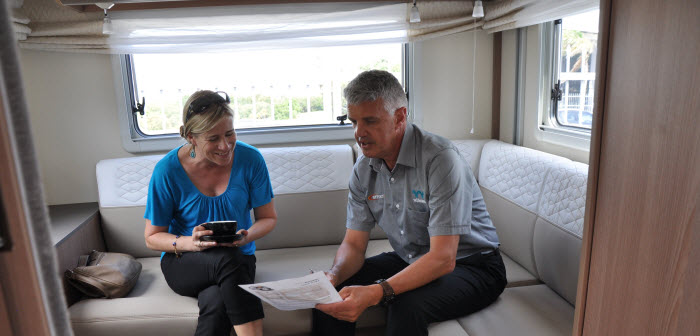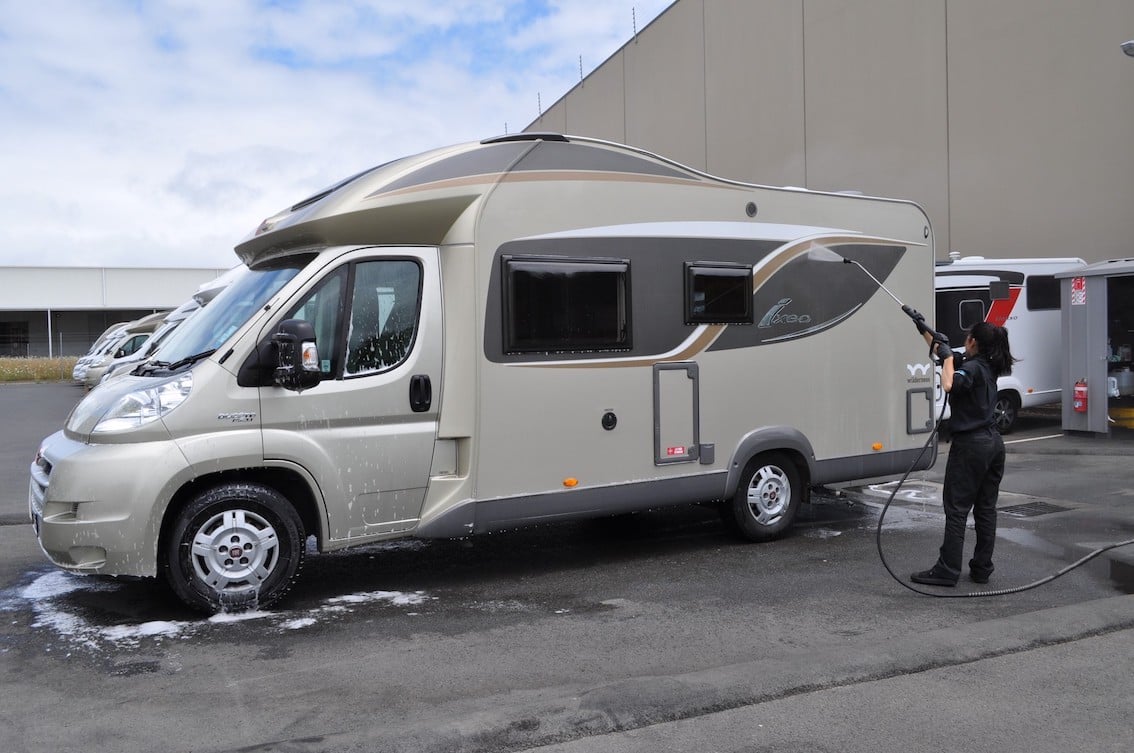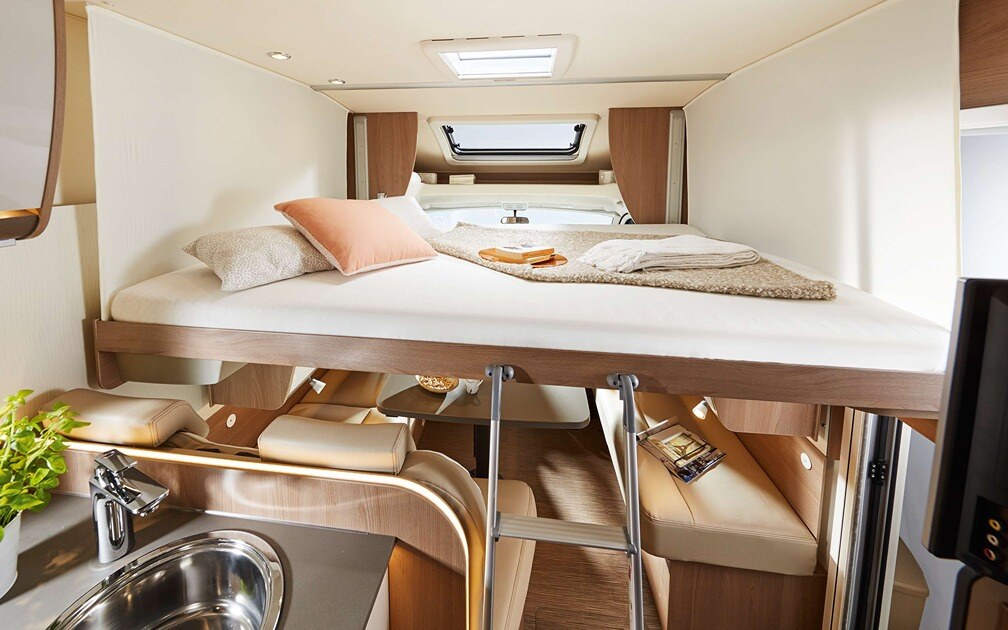Life simply seems more fun on the road. You and your motorhome will have shared some memorable experiences. But what happens when it comes time to upgrade, downsize, or retire from motorhome life altogether?

You’ll want to prepare, stage, price and present your motorhome well to achieve a great result.
|
Table of Contents |
Prepare your motorhome for sale
Ensure your motorhome is ready for prospective buyers to check over. If it’s been parked up or kept in storage for a while, the following steps are particularly important.
1. Check appliances, plumbing, fittings and in-cab functions
Inspect all of your motorhome’s appliances to ensure they are working properly. Check the operation of your oven, fridge, freezer, basins, shower and toilet. Consider getting any faults or annoyances looked at by a professional.
Also check your motorhome’s faucets, sockets, fittings and gas cylinder. Do any obvious breaks or imperfections need repairing or replacing?
Test your in-cab functions too. Potential buyers will want to test drive your motorhome before committing to a sale, so make sure you check that your indicators, headlights and brake lights are working. Plug your music and other devices into USB outlets to ensure they’re still functioning.
Make sure your motorhome battery is working well. Charge it on mains power for at least 24 hours. If it’s not holding its charge, get it checked at a workshop.
2. Use your own mechanical know-how
Save time and money by doing some maintenance work yourself. Here are a few tasks to consider.
Changing filters
Fuel filters
Fuel filters need to be replaced every two years. If your replacement fuel filter leaks because it doesn’t seal properly, you may have to replace the housing at the same time.
Air filters
These are designed to filter out dust and debris to help your motorhome engine breathe clean air. If they’re discoloured or dirty, you should replace them as they affect your engine’s efficiency.
Pollen filters
Pollen filters reduce the levels of pollen in the cab. You can locate them near the vent at your windscreen’s base or sometimes behind the dashboard centre console.
Topping up or replacing fluids
Brake fluid
Filling up your brake fluid reservoir to the mark is easily done, but to replace it you’re best to take your motorhome to a service centre.
Engine oil
Motorhome manufacturers recommend specific oil blends for each of their models. Check the specific requirements for your engine in your owner’s manual.
If you feel confident enough to change your motorhome’s oil, remember to have a drainage pan large enough to take the old oil and to drop it off (perhaps in the empty new-oil container) at a refuse station.
Engine coolant
Like engine oil, coolant or antifreeze is specified in the motorhome manual. Check whether your coolant is concentrated or not. If it is, you’ll have to dilute it using distilled rather than tap water.
Power steering fluid
Look at your motorhome manufacturer’s specifications and top up your power steering fluid as instructed.
Replacing bulbs
Headlight bulbs on most motorhomes are able to be replaced without having to remove the headlights. To replace your taillight bulbs, you may have to partially disassemble their housing.
Testing for water tightness
Buyers will want to know that the motorhome doesn’t leak. Water leaks can cause considerable damage that may be expensive to repair. At Wilderness, we can carry out a full water tightness test for you — but you can also do some simple checks yourself.
Spray water along all your seals and vents, plus around any satellite dishes and solar panels. Then take a close look to see if water has entered your motorhome from any of these possible weak points.
If your motorhome is covered by a water tightness guarantee, you’ll need to ensure the annual water tightness test is done by a certified service centre.
Preventing water leaks is an important factor in reducing your motorhome’s rate of depreciation.
Learn more about preventing water damage in motorhomes.
3. Look into getting a full service
It’s important to have any mechanical and technical issues highlighted so you can:
- Address and fix them before taking your motorhome to market
- Inform buyers about them if they’re ongoing concerns
By clearly knowing what needs fixing and what has been repaired (with detailed receipts of the work done), you’ll be able to decide on a more competitive asking price.
4. Renew any outdated certificates
Check whether the following certificates are up-to-date:
- Gas
- Electrical
- Self-containment (CSC)
If they’re not, you may want to get them renewed as they’ll make your motorhome more appealing to prospective buyers.
Stage your motorhome
First impressions make a huge difference. This is why staging your motorhome impeccably could be the most important part of preparing it for sale.
Think of it as a house-on-wheels, because it really is, and it needs to be presented as if you were selling a house. If you can stage your motorhome to feel comfy, be functional and look beautiful, you’ll have a greater chance of selling it fast and for an excellent price.
The idea is to make your motorhome more aesthetically pleasing, and therefore more appealing to potential buyers. Try the following suggestions.
Deep clean your investment
A spick-and-span looking motorhome will give you another advantage when putting it on the market. By dedicating some time and effort into sprucing it up, you’ll save yourself the extra costs of having it professionally cleaned. Plus, you’ll increase the chances of a sweet sales result.
Aim to check off the following cleaning tasks to prep your motorhome for sale.
Roof
This should be the first cleaning job you tackle considering the runoff over the sides of your vehicle. Be sure to utilise the right tools like a:
- Stable ladder
- Long-reaching telescopic brush with a hose connection
Exterior
The tools you used to clean the roof can also be useful when washing the front, sides and back of your motorhome. Having a mains water supply available will obviously make this task easier.
Stick with a fairly soft spray rather than a pressure washer as it can damage the sides and seals of your motorhome. Then:
- Use a black streak remover to get rid of black streaks while the exterior is still wet
- Clip off grills and clean them separately
- Wipe down and remove excess water from the surface
- Spray and wipe the glass windows, then buff off to remove streaks
Lastly, protect your motorhome by giving it a deep shine using a wax finish.
Kitchen
A sparkling kitchen is one that invites cooking — and that’s the impression you’re wanting to make through images of your motorhome and when a potential buyer views it in person. Ensure you:
- Wipe down all surfaces including the sink
- Clear out and clean the inside and outside of your fridge and freezer
- Use a damp cloth to wipe down cupboards and shelving
- Degrease and clean the hobs and the inside of your oven
- Empty and thoroughly clean your grey water tank to prevent unwanted smells
Bathroom
Thoroughly cleaning your motorhome bathroom helps create an impression about how well you’ve kept your vehicle. Be sure to:
- Clean the basin and wipe out the toilet
- Use a squeegee or microfibre cloth to remove streaks
- Open up the waste trap in the shower drain for a good clean out
- Add fragrance to the space with natural oil before a potential buyer takes a look
Living areas
Freshening up your motorhome’s living spaces will help make it almost feel like new again. Make sure you:
- Air any cushions outside in the sun — and replace any cushion covers that look worn or dated
- Vacuum your seats and couch, then wipe them down with a damp cloth
- Air your bedding outdoors or have it all dry cleaned
- Vacuum and mop all floors
Interior
Use a mild detergent with warm water to clean the interior walls and ceiling of your motorhome with a damp cloth.
Wipe down additional surfaces such as in the cab, and vacuum carpet areas.
When you’ve finished, remember to open your motorhome’s doors and windows to get the air flowing and prevent condensation and dampness.
Refresh your linen
Consider revitalising all your linen. Will a new, lighter tone of pillowcases, blankets and cushions make your motorhome feel like new again?
If buying new isn’t an option, refresh your linen by washing and then pressing it using an iron.
Get rid of clutter
Be sure that necessary household items are in their right place — but only keep what’s needed. You don’t want your motorhome cluttered and cramped. Remove personal items that may not appeal to others’ tastes.
Make use of props
Think about how you could add some finer touches like a small floral arrangement or freshly folded towels on the bed. You want your motorhome to feel inviting like checking into a luxurious hotel.
Snap professional images
If there’s ever a situation where a picture is worth a thousand words, then it’s while staging your motorhome.
Taking both exterior and interior photos with a semi-professional SLR camera may give your listing extra interest over others. Also consider the following when taking your staging pics:
- Wide angles — images that enhance space are critical to gaining interest
- Coverage — don’t just take a few pics, take plenty, and cover all the nooks and crannies your potential buyer will want to see
- Light — a combination of natural sunlight and subtle cabin light in darker areas will improve your photography results
- Accuracy — no one likes unwelcome surprises, so rather than avoiding an image of a dent or imperfection, add those too for an accurate pictorial story
Ideally, you want your images to give potential buyers a sense of what it will feel like to live in your motorhome.
Decide on a fair price
Working out a reasonable price for your motorhome will mean undertaking some valuable research.
Check online to see how the same model of a similar age is priced and what it’s selling for — or chat to your motorhome dealer for guidance.
Extras like solar panels can make your motorhome more appealing to a prospective buyer. Always share full details of any additional features when writing up your listing.
Bürstner, Carado and HYMER motorhomes are known for holding their value, but you’ll need to factor in:
- Mileage
- Mechanical fitness
- Any significant wear and tear over the time you’ve owned it.
Present your motorhome to prospective buyers
The final steps in preparing to sell your motorhome involve giving potential buyers all the information they need to know.
Writing an effective listing
Think back to when you purchased your motorhome. What did you need to know before being confident enough to make an offer?
Consider writing your listing as an opportunity to answer all your potential buyer’s queries. Take a look at other listings online to get an idea of what information needs to be available.
Add any extra creature comforts that could elevate your offering above others.
Remember to answer questions promptly, especially if you’re listing on an open platform such as trademe.
Showing your motorhome
It’s showtime — so you’ll want to take some time preparing your motorhome to show everything’s in superb working condition. We suggest:
- Charging up your appliances and leaving the fridge and freezer running
- Airing your motorhome out so it smells natural and not stale
- Switching on any subtle lighting that will work with natural light to help brighten the space
- Turning on some of the heating — to show it works well and to give the impression of warmth in your motorhome
- Readying any paperwork, service records and instruction manuals to be viewed when requested.
Be sure to encourage viewings by making yourself as available as possible for prospective buyers. Answer any questions as best you can and help them imagine themselves on the road enjoying your motorhome.


